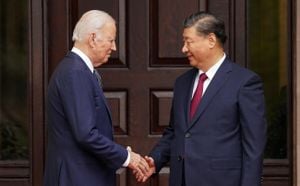The prospect of Donald Trump returning to the White House has stirred substantial conversations across the United States, particularly when it pertains to the economy. His supporters are optimistic about what his administration could do to alleviate the economic strains many have been feeling, especially those who feel the sting of inflation and rising costs. Trump, who has promised to tackle these issues head-on, campaigned heavily on his strategies for reducing prices at gas stations, slowing inflation, and making America financially accessible once again.
During Trump's recent electoral campaign, he painted himself as the solution to the economic struggles many Americans are facing, especially as prices have shot up over 21% since Joe Biden took office. Many voters expressed their belief, according to recent polls and interviews, placing their trust more heavily on Trump than on Vice President Kamala Harris when it came to economic stewardship. The rising prices have put Trump back on the political map, allowing him to secure another term.
While Trump’s campaign promised straightforward steps to stimulate the economy, including tax cuts and reducing regulatory hurdles, he also proposed implementing tariffs. Here lies the crux of the conversation: tariffs, which are taxes imposed on imported goods, may have unintended consequences on the economy. Proponents of tariffs may argue they protect American industries, but critics warn they could exacerbate inflation rather than tame it.
Diving back to his first term, we see how tariffs played significant roles. Trump made them a cornerstone of his economic strategy, and they are likely to return as prominent themes should he regain the presidency. One significant point raised is his plan to impose steep tariffs on goods imported from China—a whopping 60%—as well as 10% to 20% on virtually everything else imported to the U.S. While tariffs might seem beneficial for U.S. manufacturers, economists caution they could end up burdening American consumers by driving up the prices of everyday goods.
What does this mean for the average American? The impact is twofold. On one hand, Trump's supporters, like David Rose, a steelworker from Pennsylvania, see tariffs as instrumental to reviving the manufacturing job market. Rose believes stripping taxes on overtime pay and implementing tariffs on Chinese steel helped revitalize jobs during Trump's first presidency. He hopes for even more significant changes under another Trump administration.
But the ramifications could be broader than just job growth. According to the Tax Foundation, even modest hikes to tariffs could cause significant economic downturn. The estimates indicate prices could soar, with households facing tax increases averaging $1,253 for 10% tariffs and $2,045 for 20% tariffs. Suddenly, the promise of economic relief could morph quickly from this prime assurance of prosperity to financial strain for many American families.
Trump has been criticized for his blanket approach to tariffs, especially if they are indiscriminately applied across the board, including on imports from allied nations. Should he execute these plans, the worry is it could lead to retaliation from other countries, prompting them to impose their tariffs on American exports—an action which could hurt American businesses and consumers alike.
The economic climate cannot be overlooked: the U.S. is the second-largest importer globally. A shift from 3% current tariffs to anywhere near the proposed rates could stifle competition, disrupt supply chains, and contribute to rising overall consumer prices. For Americans already grappling with increased living costs, tariff-induced inflation could feel like salt on the wound.
Meanwhile, the sentiments echoed by his supporters along the way reveal they remain optimistic irrespective of the warnings. Many Americans are hopeful about economic reform, as evidenced by numerous interviews. Trump’s supporters are especially eager for his return to strategies they believe will bolster the economy, noting their desires for lower taxes, increased job opportunities, and economic revival.
Take Juan Felipe Paredes, for example; this Miami native now running a restaurant in Florida views Trump's leadership as pivotal to revitalizing the economy. He believes the sluggishness of recent years can be turned around. He sees Trump fulfilling his promises by nurturing the economy, improving job offerings, and assisting working-class citizens. He wishes to see immediate action against illegal immigration, connecting this to national security and financial strain.
The opinion piece from the R Street Institute cautions—a potential Trump administration could also lead to significant drawbacks. It discusses the risk of heightened tariffs collapsing economic recovery by inflaming inflation—the very thing Trump touted himself as reversing. Economists uniformly stress the need for caution with such heavy-handed tariffs, warning they could harm U.S. citizens more than they help them.
And then there’s Steve Degenfelder, who has been working as a landman for oil companies. He, too, is hopeful of lower gas and oil prices under Trump. Throughout his job, he has recognized how lower energy costs translate to wider economic benefits, allowing transportation to become cheaper, which can stimulate job growth across other segments. Degenfelder insists this leads to overall prosperity not just for Wyoming but nationally.
While many expect Trump to take serious steps toward controlling immigration and reinvigorate sectors reliant on natural resources, it’s also juxtaposed with the fears surrounding those tariffs. Critics point out the dangers of misunderstanding economics. These tariffs entail costs on businesses, which inevitably trickle down to consumers, worsening inflation.
Jeanne Solnordal, another enthusiastic Trump supporter, emphasizes expectations from Trump’s housing proposals aimed at making home ownership more accessible. She links Trump’s stance on controlling the border as being necessary to address crime and job markets, echoing sentiments shared by many voters across the U.S. who feel economic stability is tethered to such policies.
Every individual perspective provides an insight, and it’s obvious many Americans are awaiting concrete actions from Trump with interest. They want to see immediate action on inflation, tariffs, and more. If he intends to use tariffs the way he did previously, he may earn the ire of economists and everyday Americans alike.
Regardless of whether one supports Trump or not, the tides of change are seemingly poised to wash over the nation once again. The results of the strategies he chooses to implement, including tariffs, remain to be seen. If he’s wise, he’ll tread carefully to balance the economic growth desired by his supporters without the unintended inflationary consequence on American families already grappling from financial strain.
The coming months could hold significant changes, with many hoping for Trump to deliver on the economic stability he promised. They expect him to manage the economy smartly, listening closely to those individuals supporting his return who are desperate for relief from the burdens of rising prices, limited jobs, and uncertainty. The question remains: can he turn back the clock to bring back stability, or will his attempts to regulate through tariffs backfire, leaving many Americans keeping one eye on their wallets?



